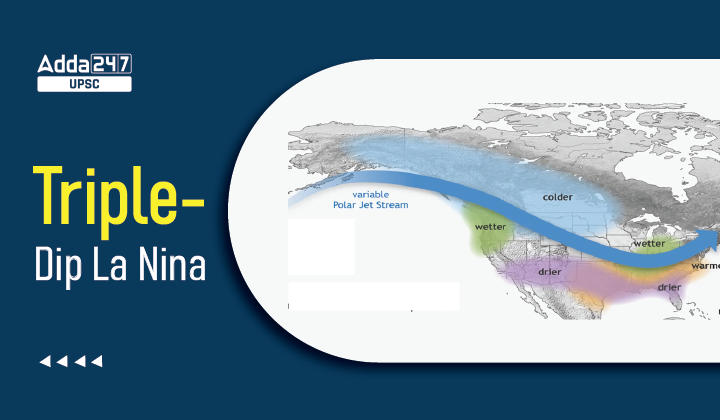Table of Contents
Triple-Dip La Nina: Relevance for UPSC Exam
General Studies I- Climate Change.
Triple-Dip La Nina: In News
Parts of the world are expected to experience severe weather for the rest of the year and into 2023, as part of a rare “triple dip La Nina” event, according to the World Meteorological Organization (WMO).
El Nino and La Nina
- While El Nino, the more common expression, is the abnormal surface warming observed along the eastern and central regions of the Pacific Ocean (the region between Peru and Papua New Guinea).
- The La Nina is an abnormal cooling of these surface waters.
- Together, the El Nino (Warm Phase) and La Nina (Cool Phase) phenomena are termed as El Nino Southern Oscillation (ENSO).
- These are large-scale ocean phenomena which influence the global weather — winds, temperature and rainfall. They have the ability to trigger extreme weather events like droughts, floods, hot and cold conditions, globally.
- Each cycle can last anywhere between 9 to 12 months, at times extendable to 18 months — and re-occur after every three to five years.
- Meteorologists record the sea surface temperatures for four different regions, known as Nino regions, along this equatorial belt.
- Depending on the temperatures, they forecast either as an El Nino, an ENSO neutral phase, or a La Nina.
What is the “Triple-Dip” La Nina?
- A “triple-dip” La Nina is a multiyear cooling of the surface temperature of the equatorial Pacific Ocean, which can cause droughts, fierce winds and heavy rainfall.
- According to WMO, the current La Nina is projected to span three consecutive northern hemisphere winters. It began in September 2020.
- If it continues for the next six months, it will be the first “triple-dip” La Nina event of the 21st century, WMO says.
How rare is this triple-dip?
- It is exceptional to have three consecutive years with a La Nina event.
- Its cooling influence is temporarily slowing the rise in global temperatures – but it will not halt or reverse the long-term warming trend.
- La Nina’s are usually preceded by El Nino, a weather pattern that warms the surface of the eastern tropical Pacific Ocean.
- However, an El Nino event did not occur before the current La Nina.
Triple-Dip La Nina: Earlier Instances
- La Nina’s occurred several times between 1903 to 2010 and 2010 to 2012.
- This would be the first “triple-dip” La Nina this century.
- However, it is not unprecedented for the weather pattern to last more than nine months to a year, which is typical for a La Nina.
Triple-Dip La Nina: Impact
- In the Indian context, La Nina is associated with good rainfall during the monsoon season.
- This is the opposite of El Nino which is known to suppress monsoon rainfall.
- Thus, a continued spell of La Nina could lead to expectation of another year of good, or normal, rainfall during the monsoon.
- Until now, the monsoon season this year has produced 7% more rain compared to normal. Last year, the seasonal rainfall was almost 100%.
- But, even though powerful, ENSO condition is only one of the several factors affecting monsoon rainfall in India.
Triple-Dip La Nina: Impact on rainfall
- There is no one-on-one correlation between the ENSO condition and the amount of rainfall.
- Also, the influence of ENSO is at a macro level.
- There are wide variations in rainfall at the local level, which are getting exacerbated by climate change.
Differential impacts of this triple-dip event
- The continuance of La Nina further into 2023 is not bad news from the Indian standpoint. But it is not the same for many other regions where La Nina has very different impacts.
- In most parts of the United States, for example, La Nina is associated with very dry winters.
- In Australia and Indonesia, and generally in the tropical region, La Nina is expected to bring more rainfall.
- The excessive rainfall in Pakistan, which is experiencing its worst flooding disaster, can also be blamed in part on La Nina.
- It said that the persistence of La Nina was most likely to result in a worsening of the drought in Africa.
Triple-Dip La Nina: Climate change link
- Every unusual weather event these days is attributed to climate change, but science is not conclusive right now.
- The occurrences of El Nino or La Nina are not very regular.
- Sometimes they emerge every two years, at other times there has been a gap of even seven years.
- Historical records do not go very far in the past.
- As a result, the natural variability of ENSO is not understood very clearly.
- And when the natural variability itself is not clear, the influence of global warming is difficult to quantify.
- But there is clearer evidence of another kind of linkage with global warming.
- During La Nina years, the colder surfaces allow the oceans to absorb more heat from the atmosphere.
- Consequently, the air temperatures tend to go down, producing a cooling effect.




 TSPSC Group 1 Question Paper 2024, Downl...
TSPSC Group 1 Question Paper 2024, Downl...
 TSPSC Group 1 Answer key 2024 Out, Downl...
TSPSC Group 1 Answer key 2024 Out, Downl...
 UPSC Prelims 2024 Question Paper, Downlo...
UPSC Prelims 2024 Question Paper, Downlo...
